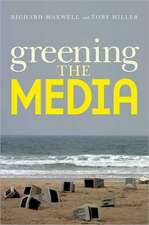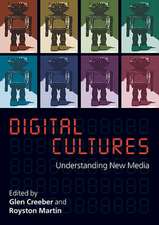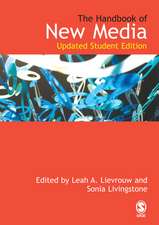Media Resistance: Protest, Dislike, Abstention
Autor Trine Syvertsenen Limba Engleză Hardback – 9 apr 2017
This book is open access under a CC BY license.
New media divide opinion; many are fascinated while others are disgusted. This book is about those who dislike, protest, and try to abstain from media, both new and old. It explains why media resistance persists and answers two questions: What is at stake for resisters and how does media resistance inspire organized action?
Despite the interest in media scepticism and dislike, there seems to be no book on the market discussing media resistance as a phenomenon in its own right. This book explores resistance across media, historical periods and national borders, from early mass media to current digital media.
Drawing on cases and examples from the US, Britain, Scandinavia and other countries, media resistance is discussed as a diverse phenomenon encompassing political, professional, networked and individual arguments and actions.
| Toate formatele și edițiile | Preț | Express |
|---|---|---|
| Paperback (1) | 214.53 lei 43-57 zile | |
| Springer International Publishing – 17 iul 2018 | 214.53 lei 43-57 zile | |
| Hardback (1) | 220.68 lei 43-57 zile | |
| Springer International Publishing – 9 apr 2017 | 220.68 lei 43-57 zile |
Preț: 220.68 lei
Nou
Puncte Express: 331
Preț estimativ în valută:
42.23€ • 43.84$ • 35.21£
42.23€ • 43.84$ • 35.21£
Carte tipărită la comandă
Livrare economică 24 martie-07 aprilie
Preluare comenzi: 021 569.72.76
Specificații
ISBN-13: 9783319464985
ISBN-10: 3319464981
Pagini: 153
Ilustrații: VII, 153 p.
Dimensiuni: 148 x 210 x 17 mm
Greutate: 0.35 kg
Ediția:1st ed. 2017
Editura: Springer International Publishing
Colecția Palgrave Macmillan
Locul publicării:Cham, Switzerland
ISBN-10: 3319464981
Pagini: 153
Ilustrații: VII, 153 p.
Dimensiuni: 148 x 210 x 17 mm
Greutate: 0.35 kg
Ediția:1st ed. 2017
Editura: Springer International Publishing
Colecția Palgrave Macmillan
Locul publicării:Cham, Switzerland
Cuprins
Chapter 1. Media resistance: Connecting the dots.- Chapter 2. Resistance to early mass media.- Chapter 3. Evil media in Dystopian Fiction.- Chapter 4. “Get a life!” Anti-television agitation and activism.- Chapter 5. “Caught in the net”: Disappointment, detox and self-help.- Chapter 6. What if resisters were right? Media resistance goes to the movies.- Chapter 7. Conclusion: The persistence of media resistance.- Bibliography.- Index.
Notă biografică
Trine Syvertsen is professor of Media Studies at the University of Oslo. She has published extensively in the field of media history, public service broadcasting, television studies, and media policy. She is co-author of The Media Welfare State: Nordic Media in the Digital Era, published in 2014.
Textul de pe ultima copertă
‘Trine Syvertsen takes us on a historical journey through the underexplored history of how people and societies have been resisting media, from protesting and criticizing to outright rejecting them. The book is well-researched, insightful and, most of all, refreshing as it inspires readers to look and think beyond the more obvious and well-trodden paths when studying media.’
- Hilde Van den Bulck, Prof. Of Communication Studies, University of Antwerp, Belgium
This book is about those who dislike, protest, and try to abstain from media, both new and old. It explains why media resistance persists and answers two questions: What is at stake for resisters and how does media resistance inspire organized action? Yet, despite the interest in media scepticism and dislike, there seems to be no book on the market discussing media resistance as a phenomenon in its own right. This book explores resistance across media, historical periods and national borders, from early mass media to current digital media. Drawing on cases and examples from the US, Britain, Scandinavia and other countries, media resistance is discussed as a diverse phenomenon encompassing political, professional, networked and individual arguments and actions.
This book is open access under a CC BY license.
- Hilde Van den Bulck, Prof. Of Communication Studies, University of Antwerp, Belgium
This book is about those who dislike, protest, and try to abstain from media, both new and old. It explains why media resistance persists and answers two questions: What is at stake for resisters and how does media resistance inspire organized action? Yet, despite the interest in media scepticism and dislike, there seems to be no book on the market discussing media resistance as a phenomenon in its own right. This book explores resistance across media, historical periods and national borders, from early mass media to current digital media. Drawing on cases and examples from the US, Britain, Scandinavia and other countries, media resistance is discussed as a diverse phenomenon encompassing political, professional, networked and individual arguments and actions.
This book is open access under a CC BY license.
Caracteristici
Explores media resistance as an integrated part of culture, rather than as incidents of moral or media panic
Draws on political and organizational sources, personal testimonies, fiction and non-fiction bestsellers as well as dystopian films to show how the media are placed in a villainous and disruptive role
Takes a historical perspective, looking at early resistance to books, print, cinema, radio and comics in the 1800s and 1900s; resistance to television in the late 1900s; and resistance to online and social media from around 2000
Draws on political and organizational sources, personal testimonies, fiction and non-fiction bestsellers as well as dystopian films to show how the media are placed in a villainous and disruptive role
Takes a historical perspective, looking at early resistance to books, print, cinema, radio and comics in the 1800s and 1900s; resistance to television in the late 1900s; and resistance to online and social media from around 2000












